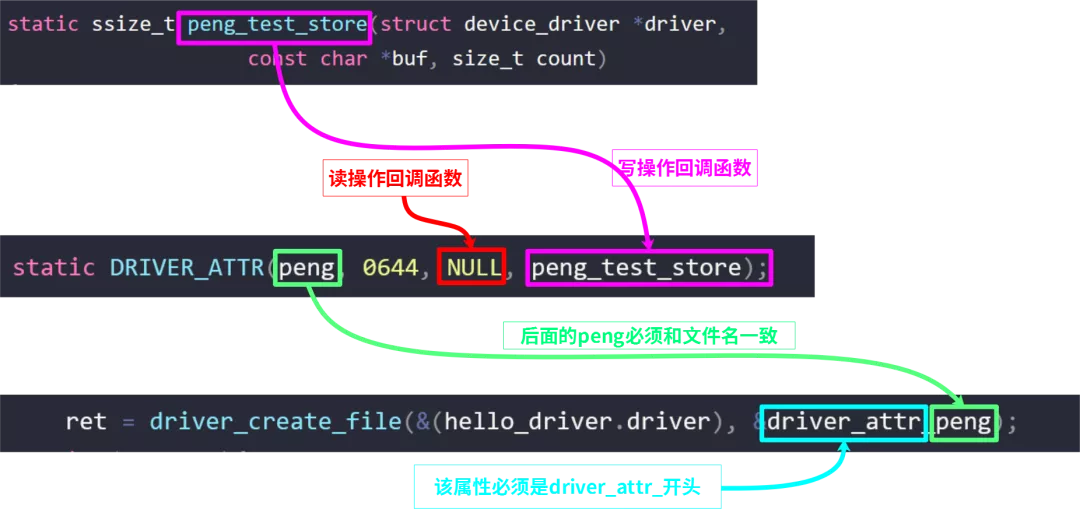Linux驱动小技巧 | 利用DRIVER_ATTR实现调用内核函数
1. 前言
很多朋友在调试驱动的时候,都会遇到这样一个场景:修改一个参数,然后调用某个内核中的函数。
比如将某个gpio的值拉高/拉低,修改某个寄存器的值等等。
如果每一个参数都通过字符设备的ioctl接口,增加对应的cmd,会比较麻烦,
研究内核的计算机大牛门怎么会容忍这种事发生,
于是设计出了DRIVER_ATTR这个宏,完美解决这个需求。
下面一口君通过一个简单的实例,给大家讲解如何使用DRIVER_ATTR。
2. DRIVER_ATTR定义
该宏定义的文件如下:include/linux/device.h
struct driver_attribute {
struct attribute attr;
ssize_t (*show)(struct device_driver *driver, char *buf);
ssize_t (*store)(struct device_driver *driver, const char *buf,
size_t count);
};
#define DRIVER_ATTR(_name, _mode, _show, _store) \
struct driver_attribute driver_attr_##_name = __ATTR(_name, _mode, _show, _store)
__ATTR定义于文件 include/linux/sysfs.h
#define __ATTR(_name, _mode, _show, _store) { \
.attr = {.name = __stringify(_name), .mode = _mode }, \
.show = _show, \
.store = _store, \
}
说明
_name:名称,也就是将在sys fs中生成的文件名称。
_mode:上述文件的访问权限,与普通文件相同,UGO的格式,最高权限0644,否则会报错。
_show:显示函数,cat该文件时,此函数被调用。
_store:写函数,echo内容到该文件时,此函数被调用。
3. 使用步骤定义一个写操作的回调函数:
static ssize_t peng_test_store(struct device_driver *driver,
const char *buf, size_t count)
{
//对参数进行检查
if(NULL == buf || count >255 || count == 0 || strnchr(buf, count, 0x20))
return -1;
printk("buf:%s count:%d\n",buf,count);
return count;
}
声明该函数与文件节点关系
static DRIVER_ATTR(peng, 0644, NULL, peng_test_store);
创建文件节点:
ret = driver_create_file(&(hello_driver.driver), &driver_attr_peng);
if (ret < 0){
dev_err(&pdev->dev, "could not create sysfs files\n");
ret = -ENOENT;
}
这几个名字之间关系如下:

4. 源码
本实验代码分为两个模块 device、driver, 分别定义结构体platform_device、platform_driver并注册到platform总线。
完整源码如下:
device.c
#include <linux/init.h>
#include <linux/module.h>
#include <linux/platform_device.h>
#include <linux/ioport.h>
static void hello_release(struct device *dev)
{
return;
}
static struct platform_device hello_device =
{
.name = "duang",
.id = -1,
.dev.release = hello_release,
};
static int hello_init(void)
{
printk("hello_init \n");
return platform_device_register(&hello_device);
}
static void hello_exit(void)
{
printk("hello_exit \n");
platform_device_unregister(&hello_device);
return;
}
MODULE_LICENSE("GPL");
module_init(hello_init);
module_exit(hello_exit);
driver.c
#include <linux/init.h>
#include <linux/module.h>
#include <linux/kdev_t.h>
#include <linux/fs.h>
#include <linux/cdev.h>
#include <linux/device.h>
#include <asm/io.h>
#include <linux/platform_device.h>
#include <linux/ioport.h>
static int hello_probe(struct platform_device *pdev);
static int hello_remove(struct platform_device *pdev);
static ssize_t peng_test_store(struct device_driver *driver,
const char *buf, size_t count)
{
if(NULL == buf || count >255 || count == 0 || strnchr(buf, count, 0x20))
return -1;
printk("buf:%s count:%d\n",buf,count);
return count;
}
static DRIVER_ATTR(peng, 0644, NULL, peng_test_store);
static struct platform_driver hello_driver =
{
.probe = hello_probe,
.driver.name = "duang",
.remove = hello_remove,
};
struct resource *res;
static int hello_probe(struct platform_device *pdev)
{
int ret;
printk("match ok \n");
ret = driver_create_file(&(hello_driver.driver), &driver_attr_peng);
if (ret < 0){
dev_err(&pdev->dev, "could not create sysfs files\n");
ret = -ENOENT;
}
return 0;
}
static int hello_remove(struct platform_device *pdev)
{
printk("hello_remove \n");
return 0;
}
static int hello_init(void)
{
printk("hello_init \n");
return platform_driver_register(&hello_driver);
}
static void hello_exit(void)
{
printk("hello_exit \n");
platform_driver_unregister(&hello_driver);
return;
}
MODULE_LICENSE("GPL");
module_init(hello_init);
module_exit(hello_exit);
Makefile
ifneq ($(KERNELRELEASE),)
obj-m:=device.o driver.o
else
KDIR :=/lib/modules/$(shell uname -r)/build
#KDIR :=/home/peng/linux-3.14
PWD :=$(shell pwd)
all:
make -C $(KDIR) M=$(PWD) modules
clean:
rm -f *.ko *.o *.mod.o *.symvers *.cmd *.mod.c *.order
endif
5. 编译运行
第一步:编译 
第二步:加载模块驱动  第三步:查看生成的文件节点:
第三步:查看生成的文件节点: 
第四步:通过下面命令向节点输入一个数字(要管理员权限):
echo 1 > peng

由结果可知,我们通过向文件peng写入一个字符,实现了调用函数peng_test_store(),并且字符1传递给了参数buf,字符个数传递给了count。
其中目录duang是由结构体变量hello_driver 给出:
static struct platform_driver hello_driver =
{
.driver.name = "duang",
};
6. 一次注册多个节点
需要借助结构体
drivers\input\touchscreen\ads7846.c
static ssize_t ads7846_pen_down_show(struct device *dev,
struct device_attribute *attr, char *buf)
{
struct ads7846 *ts = dev_get_drvdata(dev);
return sprintf(buf, "%u\n", ts->pendown);
}
static DEVICE_ATTR(pen_down, S_IRUGO, ads7846_pen_down_show, NULL);
static ssize_t ads7846_disable_show(struct device *dev,
struct device_attribute *attr, char *buf)
{
struct ads7846 *ts = dev_get_drvdata(dev);
return sprintf(buf, "%u\n", ts->disabled);
}
static ssize_t ads7846_disable_store(struct device *dev,
struct device_attribute *attr,
const char *buf, size_t count)
{
struct ads7846 *ts = dev_get_drvdata(dev);
unsigned int i;
int err;
err = kstrtouint(buf, 10, &i);
if (err)
return err;
if (i)
ads7846_disable(ts);
else
ads7846_enable(ts);
return count;
}
static DEVICE_ATTR(disable, 0664, ads7846_disable_show, ads7846_disable_store);
static struct attribute *ads784x_attributes[] = {
&dev_attr_pen_down.attr,
&dev_attr_disable.attr,
NULL,
};
static struct attribute_group ads784x_attr_group = {
.attrs = ads784x_attributes,
};
err = sysfs_create_group(&mydevice->dev.kobj, &ads784x_attr_group);
7. 补充
当然_ATTR不是独生子女,他还有一系列的姊妹__ATTR_RO宏只有读方法,__ATTR_NULL等等
如对设备的使用 DEVICE_ATTR
对驱动使用 DRIVER_ATTR
对总线使用 BUS_ATTR
对类别 (class) 使用 CLASS_ATTR
好了,大家后面在调试驱动的时候别忘了有这些宏可以使用。
© 版权声明
文章版权归作者所有,未经允许请勿转载。
 蜀ICP备20004578号
蜀ICP备20004578号